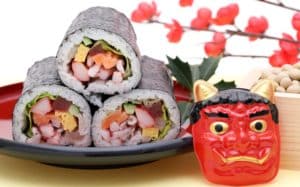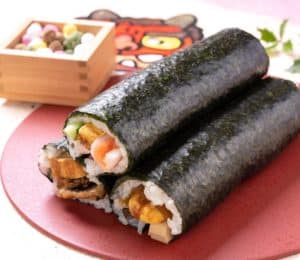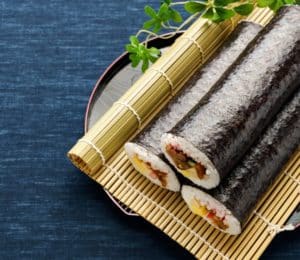The tradition of ehomaki, the sushi for Setsubun
Setsubun is a Japanese festival aimed at warding off evil spirits. It takes place on February 3, marking the separation between winter and spring according to the traditional Japanese solar period. It is believed that bad things, represented by demons, tend to emerge during seasonal changes. To send away these monsters, the Japanese practice mamemaki, a tradition where they throw beans while shouting “Oni wa soto, Fuku wa uchi” (“Demons out, happiness in”). They also have the custom of eating ehomaki (or ehoumaki), a thick sushi roll.
What is ehomaki?

Picture: Ehomaki
Ehomaki is a thick maki consumed on Setsubun day. “Eho” refers to the direction of the god of good fortune, and “maki” to rolled sushi. It is believed that eating this roll in the right direction brings luck and happiness. This direction changes every year, so it’s essential to check beforehand. In 2024, it is towards the east/northeast.
History of ehomaki
The history of ehomaki originates in Osaka, following a promotional campaign by the Sushi and Nori Seaweed Association. While several theories exist, all converge on the desire for commercial prosperity, health, and family safety. Today, eating ehomaki on Setsubun day is a widespread tradition throughout Japan.
Rules for eating ehomaki

Picture: Rules for eating ehomaki
There are specific rules for enjoying ehomaki. It must be eaten whole, without cutting it, as it contains various ingredients symbolizing good fortune. Silence is also required, as speaking is said to let blessings escape from the mouth.
What ingredients to put in ehomaki?

Picture: Ehomaki
Ehomaki ingredients vary, but tradition dictates it should contain seven different ingredients, referring to the “seven gods of good fortune.” Among the classic ingredients are grilled eel, egg, shiitake mushroom, sliced gourd (kanpyo), cucumber, sakuradenbu (seasoned fish), and tofu. However, in recent years, many variations have emerged, including seafood and meat.
Ehomaki recipe

Picture: Ehomaki recipe
Discover our blog article dedicated to the ehomaki recipe!
If you are interested in our Japanese products,
do not hesitate to contact us through our contact form.
Would you like to be informed of our blog posts?
Subscribe to our newsletter.




